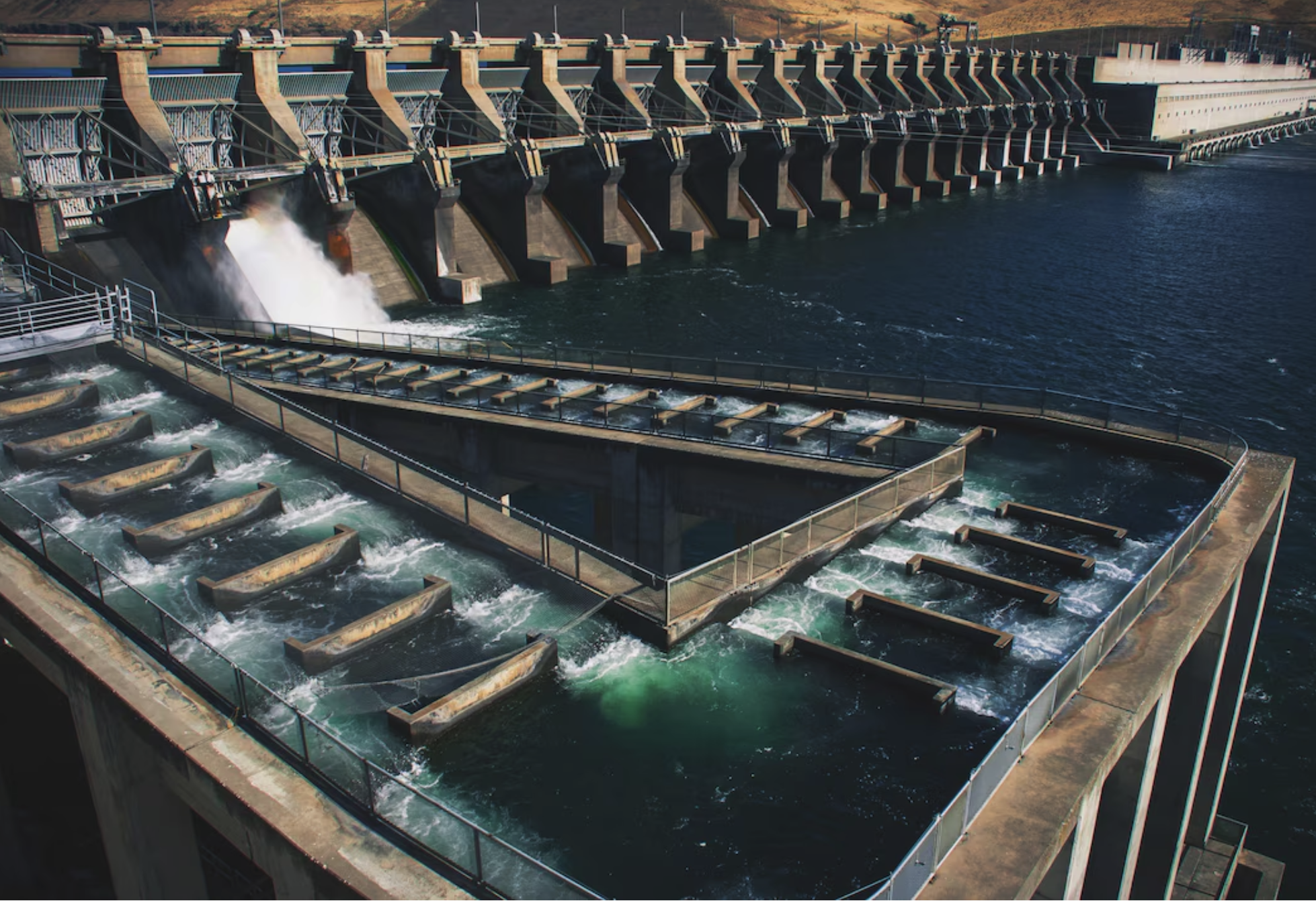Maintenance needed on Modern Marvel that moves the weight of the Great Pyramid of Giza almost twice annually; Salmon not so much
The Dalles Dam looking east.
By Tom Peterson
The Dalles, Ore., Feb. 17, 2025 — Dams at Bonneville, The Dalles and John Day are expected to be shut to barge and boat traffic between March 9 and March 22 as regular maintenance of the locks is undertaken to ensure the critical lift and drop stations in the shipping channel functions properly for the next year.
The Columbia-Snake River System is a critical trade corridor supporting $24 billion in commerce annually, according to the U.S. Army Corps of Engineers (USACE), Portland District.
Moving commodities on water is far more efficient as there is far less friction than that of the wheel, and therefore less energy required than say trucks or trains.
A U.S. National Waterways Foundation “study shows that barges can move a ton of cargo 647 miles with a single gallon of fuel, an increase from an earlier estimate of 616 miles. In contrast, trains can move the same ton of cargo 477 miles per gallon, and trucks can move the same ton of cargo 145 miles per gallon,” according to story in maritime-executive.com
And barges win on volume, hands down. A single tugboat pushing four barges is carrying about 26 million pounds of wheat or 436,500 bushels worth $2.6 million at current prices. It is key to distributing grains and other commodities such as wood chips, logs and metal scrap to the Lower Columbia.
Grains are reloaded onto ocean going bulk carriers which distribute Northwest grain all over the world.
Bulk Carriers
Food supplies and commodities shipped in mass agruably ensures that human populations survive and thrive in modern civilization and free humans to specialize in all areas of exploration, research, art and innovation.
However, Dams come at a cost.
Native Americans rely on salmon and steelhead for sustenance. They were guaranteed fishing rights in trade for their land to the U.S. Government in forced treaties created during the mass migration of settlers to the west almost two centuries ago. And they protested the dams at the outset of their construction. They warned they would lose their salmon, hunting and fishing sites, and villages. Fishing sites such as Celilo Falls, which now lies beneath the water west of Biggs Junction. They contend the dams impede fish passage as they migrate to and from the ocean, reducing returning salmon and steelhead numbers.
The fish ladder at John Day Lock and Dam allows adult fish to migrate upstream of the dam on their own. These are important aspects of the U.S. Army Corps of Engineers' fish passage facilities as they allow fish to travel at all times. From USACE website
And while dam modifications have been made to improve fish passage and large hatcheries have been constructed, salmon and steelhead returns are far from historical runs which is borne out by the data.
Correlations between the decline and causes are still hotly debated. However in 2023, President Joe Biden, the Governors of Washington and Oregon and the Confederated Tribes of Warm Springs, Yakama, Umatilla, and Nez Perce, agreed to pause litigation to undertake a $1 billion, 10 year plan to restore wild salmon populations, expand clean energy production, and reinforce the economic benefits of the Columbia River system.
More on Maintenance from the Corps:
The Corps will pause operations for two weeks beginning March 9, as the , conducts its annual navigation lock maintenance.
This scheduled closure ensures the continued reliability of the system, which moves over 50 million tons of cargo each year, including wheat, soy, corn, and minerals. The work will include routine inspections and maintenance, along with equipment upgrades at The Dalles Lock & Dam and guidewall repairs at Bonneville Lock & Dam following damage sustained over the past year.
“These maintenance periods allow our engineers and crews to inspect critical infrastructure, address minor issues before they escalate, and ultimately prevent unscheduled outages during the year,” said USACE project manager, Ross Foster. “This year, we’re also installing new monitoring instrumentation at The Dalles Lock & Dam to track key areas that have posed challenges in the past.”
Coordinated Closure Schedule
The Portland and Walla Walla Districts have aligned their schedules to minimize disruptions. The Walla Walla District's lock closure will run from March 8 through March 22, overlapping with Portland’s schedule. USACE works closely with inland shippers, cruise lines, and recreational users to ensure efficient planning around these annual maintenance periods.
Impact on Recreational Users
During the closure, recreational boaters will be unable to pass through the navigation locks along the Columbia-Snake River System. Boaters should plan accordingly and seek alternative routes or launch sites upstream or downstream of the locks. Public access to some areas near the locks may also be restricted for safety reasons.
Economic Impact
The Columbia River locks handle over 10 million tons of cargo annually, playing a key role in the $24 billion worth of goods transported through the Columbia-Snake River System each year.
In comparison, the Great Pyramid of Giza is calculated to weigh just 6 million tons - 4 million less than the annual amount of goods shipped down the Columbia River Locks.
More on the Corps
With a legacy dating back to 1871, navigation remains one of USACE Portland District’s most essential missions, supporting regional economies, agriculture, and global trade.
Support Local News
Available to everyone - even runners; Funded by readers.
Visit Portland District’s website for more information about the Columbia River locks.






